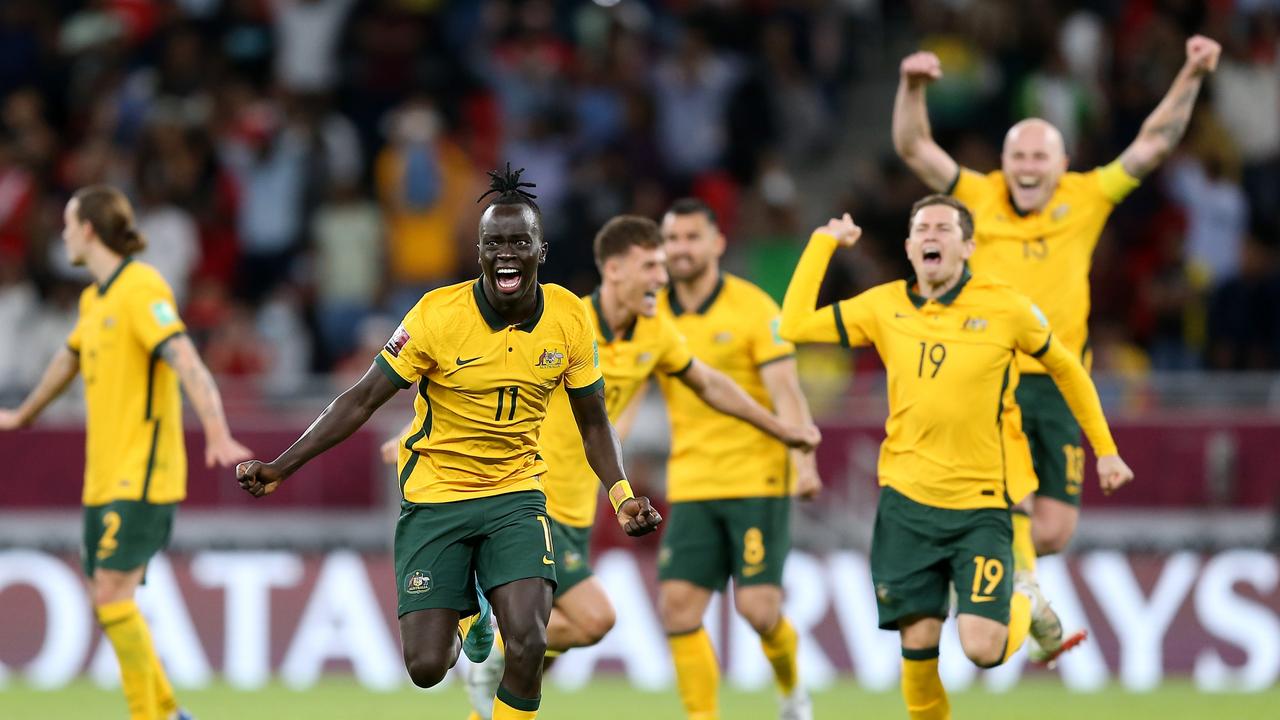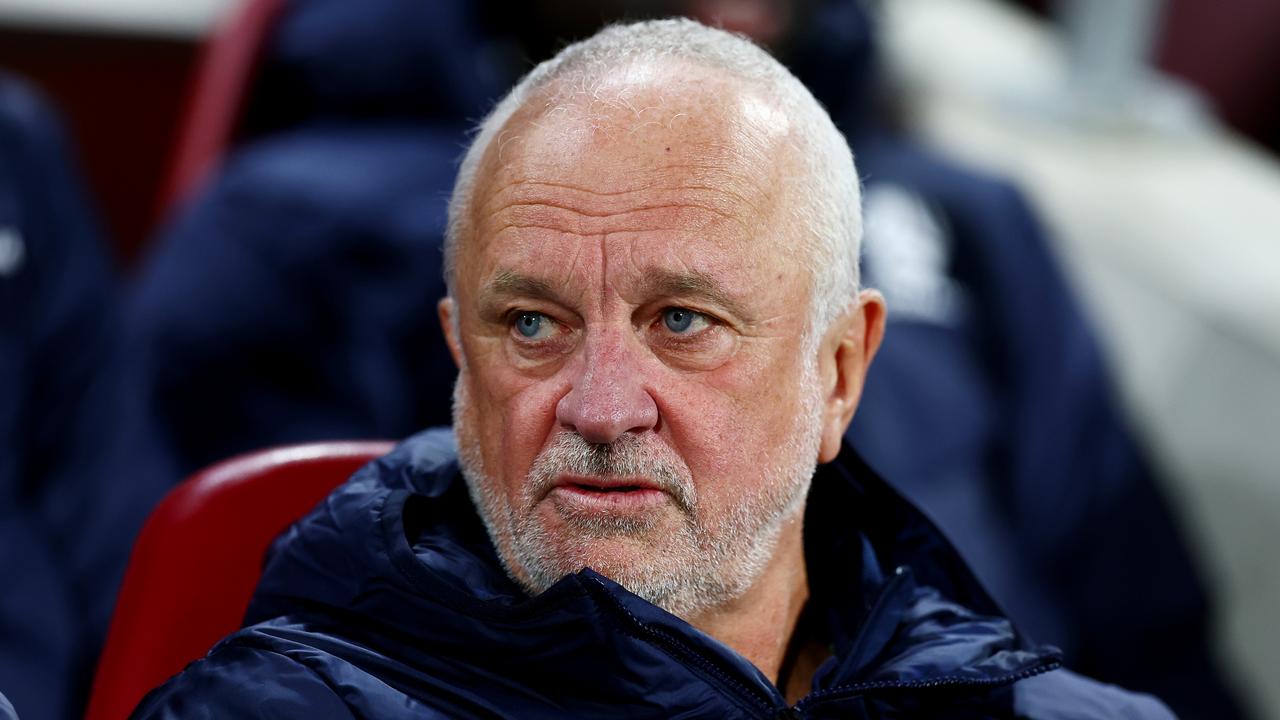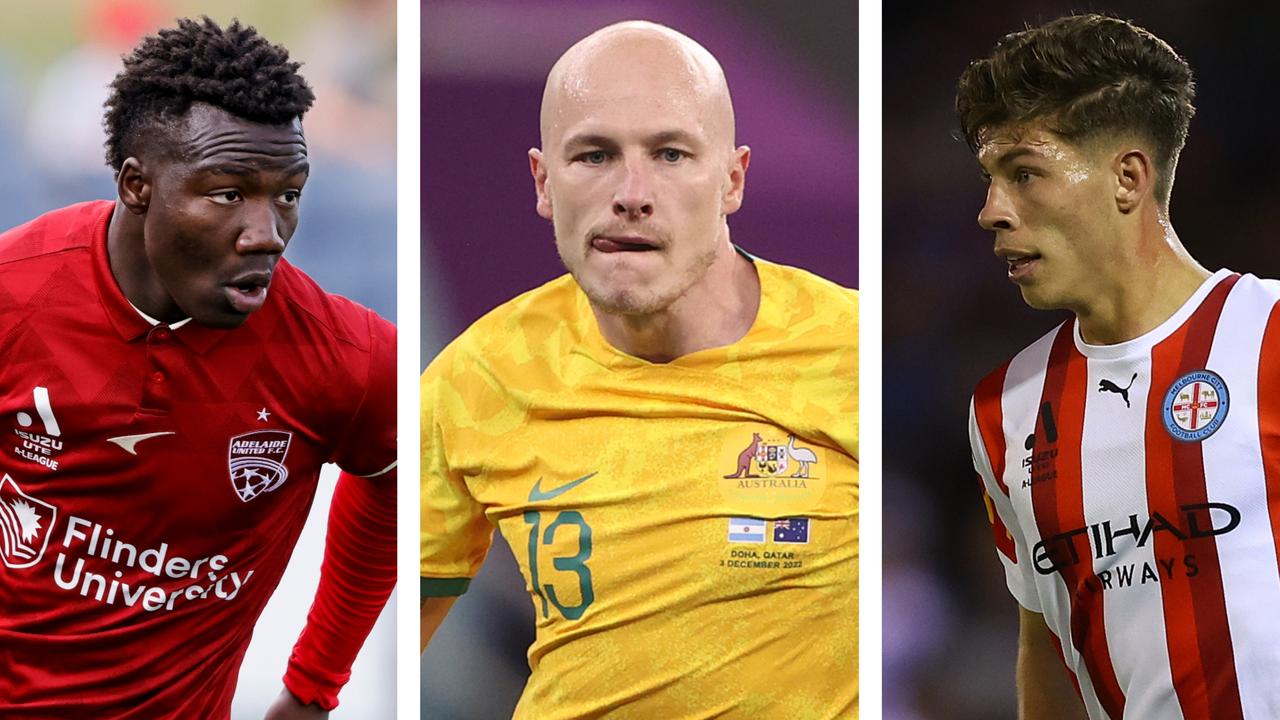Fifty years ago today, the Socceroos booked their place in the FIFA World Cup for the very first time, with Jimmy Mackay scoring a wonder-goal against the Korea Republic to punch Australia’s ticket to the 1974 tournament.
Australia wouldn’t appear at another men’s World Cup until 2006, but have qualified for every tournament since.
On Thursday night against Bangladesh, the Socceroos take the first step in the road to the next World Cup – in 2026, hosted by Canada, Mexico, and the United States.
It will be a long journey for the Socceroos to reach a sixth-straight World Cup, though major changes to the qualification format should make things easier for Australia.
But the Socceroos still have plenty of challenges to address – and the next 12 months could prove crucial.
Stream Over 50 Sports Live & On-Demand with Kayo. Join now and start streaming instantly >
HOW DOES QUALIFICATION WORK?
The 2026 tournament will be expanded from 32 teams to a whopping 48 for the first time ever, something which provides a major boost for Asian Football Confederation (AFC) nations including Australia.
The number of automatic qualification spots for the AFC will rise from four to eight – plus one more spot for the winner of a playoff against teams from other confederations – resulting in a shake-up in the qualifying format.
In this round, 36 teams were divided into nine groups of four teams. Australia’s group features Palestine, Lebanon, and Bangladesh, with the Socceroos to play each of them home and away.
Australia will play two matches this month, two in March 2024, and the final two in June.
The Socceroos must finish in the top two teams of this four-nation group to progress to the next stage, while a top-two finish also ensures qualification to the Asian Cup in Saudi Arabia in 2027.
In the next round, 18 teams (winners and runners up from the nine groups in this round) will be split into three groups of six.
The Socceroos would then play the other five teams in home-and-away games, beginning in September 2024. Finishing in the top two of the group after those ten matches ensures direct qualification to the World Cup.
But if the Socceroos finish in third or fourth in that next stage, they would then be put into a group of three teams. Australia would play the other two teams once each, with the group winner qualifying for the Cup.
Finish runner-up of the three teams and Australia would then be forced into a do-or-die series of playoffs, first against another AFC team then against nations from other confederations.
Effectively, the Socceroos will be aiming to qualify in 16 games – six at this stage, and 10 at the next.
PL TALKING POINTS: Ange’s Spurs reality laid bare by ‘painful’ images; truth about Man Utd redemption
PL WRAP: Last-minute drama rocks City amid EIGHT-goal chaos as $86m star haunts old club
Matildas, Socceroos secure new pay deal | 02:50
It’s not quite as long as the 1,008 day, 20-match road to qualifying for Qatar 2022, or the 22-game road to Russia 2018 – where they clocked up over 240,000 kilometres in travel and played more games than any other qualifying nation.
But even with the changes to the qualifying format, crisscrossing Asia for 16 games is still one of the longest qualification journeys for a World Cup.
However, there is another major difference from last time around: the Socceroos will now get to play far more matches on home soil now Covid-19 border restrictions have eased.
As Arnold said: “It’s been a really, really long time since we played here in Australia. You know, I was looking just the other day, in my reign of 44 matches, we’ve only played nine games here in Australia. So we’ve been away a long time and played a lot of football away from home.”
Irvine similarly stated: “I think for us, one of the most important things is having the chance to play in Australia, in front of our home fans again.
“I think over the last five years this is maybe the ninth or 10th game we’ve played at home, which in the context of a qualifying campaign is barely anything.
“So we don’t take these experiences for granted to play in front of our home fans.”
The greater number of qualifying spots on offer for Asia, and the new-look format, should make qualifying for 2026 significantly easier for the Socceroos.
There are more chances for redemption if they slip up and can’t finish right at the top of their group at each stage, while the larger number of groups should spread the higher-ranked teams around – meaning more matches against lower-ranked opposition.
But there is no doubt that despite the new format and the benefit of more home matches, the road to a place in the 2026 World Cup will not be an easy one.
Captain Maty Ryan said: “It’s a long journey and a gruelling one, but the fruits at the end of it are so sweet that you have no worries in confronting them and doing all you can to reach the end goal of playing in the World Cup.”
WHAT HAPPENED AT THE LAST WORLD CUP – AND SINCE?
The Socceroos enjoyed a historic performance in Qatar last year.
They led reigning champions and eventual runners-up France in their first group game before losing 4-1, but rebounded to beat Tunisia 1-0. Then they overcame Euro 2020 semi-finalists Denmark 1-0 to make it out of the group stage.
They then fell 2-1 to eventual champions Argentina in the Round of 16 despite a stellar performance where they even came close to equalising in injury time through teen sensation Garang Kuol.
Nevertheless, securing two group-stage wins was a first in Australian men’s history, and the clean sheets in both wins were also impressive and rare – not since 1974 had the Socceroos kept a World Cup clean sheet.
The win over world number 10 Denmark was also the first time the Socceroos had beaten a top-ten nation at the WC.
The Socceroos played with tenacity – that oft-spoken-about Australian fighting spirit – but were also tactically excellent, with renowned French publication L’Equipe naming coach Graham Arnold the best of any manager at the tournament.
“L’Equipe is one of the most respected and one of the harshest markers of games, coaches, players you name it,” former Socceroo Robbie Slater said at the time. “They’re the most respected in all of Europe.”
It also saw the Socceroos surge up the rankings by 11 places into 27th, their best spot since September 2012 (25th).
Arnold, having been on the brink of being sacked just six months before the World Cup after the struggling Socceroos missed out on direct qualification and were forced into the intercontinental playoffs, was handed a new deal to remain in charge through to the 2026 tournament.
Since then, he has set the Socceroos on a brutal path – facing off against some of the world’s toughest teams in a series of testing friendlies.
They faced Ecuador (#41) in a pair of fixtures in March, battled Lionel Messi’s Argentina (#1) in June, clashed with Mexico (#12) in September, before last month facing England (#4) at Wembley Stadium and New Zealand (#104).
Socceroos claim Ashes after NZ victory | 02:03
If the 2022 World Cup proved the Socceroos deserved to be on the world stage, that run of fixtures was deliberately designed to take the team to the next level, to be able to compete against the elite.
It was a rare opportunity for the Socceroos, who have struggled to squeeze friendly matches into their packed schedule in the past.
And while the results were mixed – there were wins over Ecuador and New Zealand, a sloppy draw with Mexico and three losses – far more important was the opportunity to experiment with new tactics and line-ups, with Arnold handing out a host of debuts to young talents.
“We’ve had the opportunity to test ourselves against some of world football’s best in the last six months, and our performances have shown just how effective we can be, learning a lot along the way,” Arnold said last week.
“It was a chance to grow as a group, providing opportunities to younger players in preparation for the start of the 2026 World Cup qualification cycle.
“Those performances have not only shown what we’re capable of, but reinforced a strong belief within this group as we begin an extremely important period.”
Now, the trialling phase is over. The Socceroos must turn their minds to victory – because the next few months aren’t just about World Cup qualification.
As Arnold said: “Now? It’s a World Cup qualifier. I think that experimenting is over, now it’s all about getting the tactics right, getting the players on the pitch, getting their performances right, and winning those games at all costs.”
Souttar hilariously tries to claim goal | 00:37
THE ASIAN CUP
The Asian Cup will take place from 12 January to 10 February next year, and the Socceroos will rightly believe they are contenders for just a second title after their 2015 win on home soil.
The tournament was meant to be held in China in July of this year, but that nation relinquished hosting rights last year due to Covid-19. Qatar eventually won the rights but – just like last year’s World Cup – scorching mid-year temperatures forced the rescheduling of the tournament to the cooler months.
That is arguably a blessing for the Socceroos, who have now used the additional time to squeeze in the aforementioned run of high-quality friendly matches.
But it also means that the Socceroos cannot simply focus on the longer term goal of qualifying for the 2026 World Cup and reshaping the squad to be ready for that tournament.
They must focus on the here and now – something that is also true of the Olyroos, Australia’s Under-23 team which will compete in the U23 Asian Cup in April next year. That tournament doubles as qualification for the Paris 2024 Olympics, with the Olyroos needing to finish in the top three to directly qualify, while fourth place plays off against an African team for another berth.
The Olyroos finished third at the 2020 U-23 Asian Cup to book their place at the Tokyo Olympics, the first time the men’s team had competed at the Olympics since 2008.
While they failed to make it out of their group, their development was crucial – especially given Socceroos coach Graham Arnold took on the Olyroos coaching role in a deliberate attempt to guide a new generation into Socceroos.
That approach was remarkably successful: nine of the Olyroos that featured at the 2020 Olympics went on to play at the 2022 World Cup with the senior side (10 if you count Mitchell Duke, who competed at the Olympics as a designated overage player).
As the Socceroos progress towards the 2026 World Cup, the squad will naturally need to bring in fresh faces, just as they did before the last World Cup. The development of the Olyroos, who play a similar style as the senior team – could prove crucial in that regard.
That’s why the next 12 months looms as a crucial period for both the Olyroos and the Socceroos – and not just because both teams will be contending for major silverware.
As Jackson Irvine said: “Of course this is the beginning of a long journey, but it can also be viewed as a short preparation for what’s coming in January.”
While the road to the 2026 World Cup is just beginning, Graham Arnold needs to balance competitiveness now with the long-term future of the squad. It’s hardly an enviable task.
THE SQUAD
Arnold’s squad for Thursday’s clash with Bangladesh and next week’s meeting with Palestine is largely unchanged from last month’s fixtures, with just four changes to the 23-player unit.
Veteran defender Milos Degenek was dropped after struggling for game-time at Red Star Belgrade, as is goalkeeper Tom Glover at Middlesbrough. Winger Awer Mabil was dropped, as was another gloveman in Andrew Redmayne.
The squad is a mix of youth and experience – which very much sums up the current state of play for Graham Arnold’s side.
Arnold said last month before the matches against England and New Zealand: “We are going through a bit more of a rebuild situation at the moment. When you look at the squad overall, there are 11 players who’ve had less than 10 caps, there’s five or six players that have had between 11 and 20.”
There’s been significant turnover in the last 12 months, with just nine members of the squad having competed at the World Cup in Qatar.
Midfield stalwart Aaron Mooy retired, while Nathaniel Atkinson and Riley McGree are both injured.
But a number of other players from Qatar are struggling for form or match minutes at club level, including Degenek and Bailey Wright, or Ajdin Hrustic who was arguably Australia’s best player in the qualification road to Qatar but now can’t get a game at Hellas Verona in Italy.
It’s clear from the number of debuts handed out in recent months that Arnold is looking towards the future and attempting to increase the depth of the squad – something he also prioritised when he took over after the 2018 World Cup, when a host of retirements including the likes of Tim Cahill and Mile Jedinak forced a generational shift in the squad.
Arnold used 68 different players in qualifying for the 2022 World Cup – and it would hardly be surprising if he exceeds that number this time around.
Seven players have already debuted in 2023, while 37 have been used in total. In the current squad, there are two uncapped players – Portsmouth striker Kusini Yengi and goalkeeper Ashley Maynard-Brewer of Charlton Athletic.
Maynard-Brewer is one of two young goalkeepers called up in place of more experienced heads like 34-year-old Andrew Redmayne. Maynard-Brewer was included in the September squad for the Mexico match but has not yet debuted for the Socceroos. Joe Gauci also returns to the set-up, having debuted against Ecuador in March before being left out of the past couple of squads while his Adelaide United waited for the new A-League season to begin.
The pair of young talents (at 24 and 23 years old respectively) are viewed as the likely long-term successors to captain Maty Ryan. The 31-year-old remains in fine form with AZ Alkmaar in the Netherlands and has a monopoly on the number one jersey at present, but ensuring the next generation of keepers are ready to step up is crucial, especially given the ever-present threat of injuries.
At the opposite end of the park is an equally pressing need to find long-term solutions. Yengi is one of four strikers included, alongside veterans Mitch Duke (30 caps), Jamie Maclaren (30) and Brandon Borrello (9). But with Duke 32 years old and McLaren 30, the need to plan for the future in the number nine role – arguably the position where the Socceroos have struggled for depth the most in recent years – is clear.
It’s a similar story with the rest of the attacking unit. Craig Goodwin is turning 32 next month, Martin Boyle is 30, while absent veteran Mathew Leckie is 32. While they are key contributors now – and could prove vital to a good run at the Asian Cup in January – how many will still be part of the team should Australia qualify for the World Cup in 2026?
Samuel Silvera (23) and Brandon Borrello (28) are in this squad, while Awer Mabil (28) is missing – but there’s no shortage of younger attacking talent waiting in the wings for their chance. Garang Kuol already has five caps at age 19, while Marco Tilio (22) also featured at the World Cup last year. Yengi (24) can also be deployed on the wing.
Mohamed Toure (19) earned his debut against England last month, while fellow teen sensation Nestory Irankunda (17) is set for a move to German giants Bayern Munich and has also trained with the Socceroos squad in the past.
Socceroos veteran and Toure’s former Adelaide United captain Craig Goodwin told Foxsports.com.au after that debut last month: “He’s someone with massive potential.
“He’s someone that in my opinion could be the Socceroos’ striker for the next 10 years.”
While they may not be in the team this time around – and might not become regular fixtures until later in the World Cup qualification journey – there’s no doubt that the kids are coming.
And with three years and at least 16 games on the road to the next World Cup, the young guns will get their chance.
For now, though, the Socceroos must start winning.


